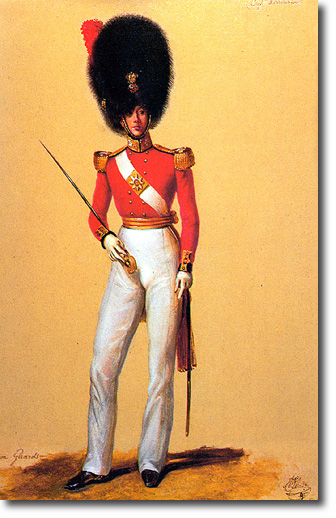|
|

 |
|
In 1831 it was decided to issue bearskins to all men of the Guards regiments to conform to the image of the Grenadier Guards. But the bearskin was a symbol of the grenadier, and the three regiments couldn't all be grenadiers because that would devalue the premier regiment, so a submission was made that the 2nd and 3rd Regiments of Foot Guards should be termed the Coldstream Fusilier Regiment of Foot Guards and the 3rd Fusilier Regiment of Foot Guards. Fusilier line regiments also wore bearskins so by naming them Fusilier Regiment they would be entitled to dress in a similar way to the Grenadiers.
The 3rd Guards accepted the submission but the Coldstream Guards regarded it as a humiliating compromise. They took on the bearskin anyway, and instead of having the expected white plume on the left side, defiantly plumped for a red plume on the right. The bearskin was far from plain as it is today; the gold tassels were retained on the right side , a rose and crown badge was adopted for the front, and the garter star used as a back badge. In this painting by Dubois Drahonet, the officer wears the coat adopted in 1830, double-breasted, without lapels. Officers' rank was indicated in the size of the epaulettes and the embroidered badges placed on them. Subalterns had a silver rose badge which appears to be the case with this officer. Captains had, in addition, a crown badge. Field officers had a garter star above both the crown and the rose. Round his waist is the gold and crimson sash worn on state occasions. The ends of this sash hang at the back of his curved sword scabbard which is of black leather and gilt fittings. The summer trousers are white with no stripe. |
Armed Forces | Art and Culture | Articles | Biographies | Colonies | Discussion | Glossary | Home | Library | Links | Map Room | Sources and Media | Science and Technology | Search | Student Zone | Timelines | TV & Film | Wargames